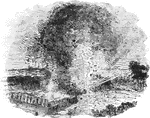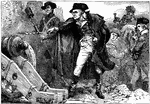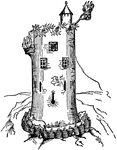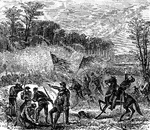Clipart tagged: ‘siege’

The Siege of Alicant
The Siege of Alicant, Spain in 1709. Caption bellow illustration: "The mine at last blew up; the rock…

After Appomattox
The Appomattox Campaign (March 29, 1865 – April 9, 1865) was a series of battles fought in Virginia…

Army of King Nebuchadnezzar
"In the thirteenth year of the reign of Nabuchodonosor, the two and twentieth day of the first month,…

Battering Ram
"The Battering Ram is an ancient military contrivance used for battering down walls. It consisted of…

Fairfax Taking Possession of Cochester
In 1189, Colchester was granted its first Royal Charter by King Richard I (Richard the Lionheart.) In…

Curtain
"Curtain, in Fortification, is the portion of rampart or wall between two bastions or two gates. In…

Blowing Up Fort Hill Bastion
As June wore on, Grant pressed the siege with vigor. Johnston tried to help Pemberton, but could not.…

Breach in Fort Pulaski
Fort Pulaski was prepared for a possible infantry attack. However, Fort Pulaski never endured a direct…

Capture of Fort Morgan, Mobile Bay
The Siege of Fort Morgan occurred during the American Civil War as part of the battle for Mobile Bay…

Siege of Boulogne by King Henry VIII, Detail of Cowdray Engraving
Detail from a larger engraving of the siege of Boulogne in 1544 during the campaigns of Henry VIII in…

The Siege of Château Gaillard, the Saucy Castle of Richard the Lionheart - Aerial View
An aerial view of the siege of Château Gaillard, also called the Saucy Castle. Construction of the…

Trojan horse
"According to the poets, it was by stratagem that this famous city was at last overcome. They tell us…

Vicksburg during the Civil War
The Vicksburg Campaign was a series of maneuvers and battles in the Western Theater of the American…

Cave Life in Vicksburg
During the siege, Union gunboats lobbed over 22,000 shells into the town and army artillery fire was…

Porter's Fleet Shelling the Batteries Vicksburg
Union forces bombarded the city all night, from 220 artillery pieces and naval gunfire from Rear Adm.…

George Washington at Siege of Yorktown
An illustration of George Washington lighting a cannon at the siege of Yorktown.

Medieval Watch Tower
"A French watch tower of the fifteenth century in time of the siege. The tower is lighted by means of…


